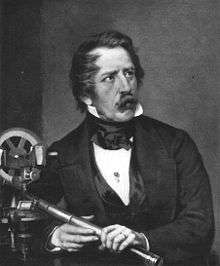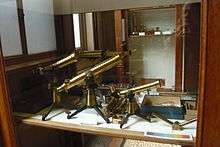Carl August von Steinheil
Carl August von Steinheil (12 October 1801 – 14 September 1870) was a German physicist, inventor, engineer and astronomer.
Carl August von Steinheil | |
|---|---|
 | |
| Born | 12 October 1801 |
| Died | 14 September 1870 (aged 68) Munich, Bavaria |
| Resting place | Alter Südfriedhof, Munich 48.127222°N 11.565°E |
| Citizenship | German |
| Alma mater | University of Erlangen |
| Scientific career | |
| Fields | Astronomy, Physics, Engineering, Mathematics |
| Institutions | University of Munich Austrian Trade Ministry C. A. Steinheil & Söhne Deutsch-Österreichischer Telegraphenverein Trade Ministry of Bavaria |
Biography

Steinheil was born in Ribeauvillé, Alsace. He studied law in Erlangen since 1821. He then studied astronomy in Göttingen and Königsberg. He continued his studies in astronomy and physics while living in his father's manor in Perlachseck near Munich. From 1832 to 1849, Steinheil was professor for mathematics and physics at the University of Munich.
In 1839, Steinheil used silver chloride and a cardboard camera to make pictures in negative from the Museum of Art and the Munich Frauenkirche, then taking another picture of the negative to get a positive, the actual black and white reproduction of a view on the object. The pictures produced were round with a diameter of 4 cm, the method was later named the “Steinheil method.”[1] It was the first daguerreotype in Germany.[2][3]
In 1846, Steinheil travelled to Naples to install a new system for weight and measure units. Three years later, he was appointed to the Board of Telegraphy of the Austrian Trade Ministry. Steinheil was tasked with designing a telegraph network for the entire empire, and helped to form the Deutsch-Österreichischer Telegraphenverein (German-Austrian Telegraph Society). In 1851, he started the Swiss telegraph network. Steinheil returned Munich as konservator (curator) of the mathematical-physical collections and ministerial secretary in the Trade Ministry of Bavaria.
In 1854, he founded C. A. Steinheil & Söhne, an optical-astronomical company.[2][3] The company built telescopes, spectroscopes and photometers – one of Steinheil's inventions, used to measure brightness. C.A. Steinheil & Söhne produced large telescopes for observatories in Uppsala, Mannheim, Leipzig, Utrecht.[2][3] The company also produced refractors and reflectors with silver-covered mirrors. The process for creating the silvering was developed by Steinheil's friend Justus Liebig. In 1862, Steinheil's sons started managing the company.
Steinheil died in Munich in Bavaria on 14 September 1870. He was buried in the Alter Südfriedhof cemetery.
Inventions
- Ground electricity
- Print telegraph (not made public)
- Electric clock
- Steinheil script (code to print dots on paper via telegraph, not used due to the adoption of Morse code)
- Steinheil doublet, a flint-first achromatic doublet
- Silver coating of curved glass surfaces (together with Léon Foucault) paving the way for the rise of reflecting telescopes.
Legacy
Some sources state that Steinheilite, a transparent mineral that resembles blue quartz but is actually a form of iolite, was named after Carl von Steinheil.[3] However, the name was in use as early as 1811, too early to be named after Carl von Steinheil, and sources from that time instead attribute it to Fabian Steinheil, the Russian military governor of Finland.[4]
References
- "Steinheil-Verfahren". Archived from the original on 2007-09-29. Retrieved 2006-08-04.
- Gilman, D. C.; Peck, H. T.; Colby, F. M., eds. (1905). . New International Encyclopedia (1st ed.). New York: Dodd, Mead.
- Rines, George Edwin, ed. (1920). . Encyclopedia Americana.
- Sowerby, James (1811), Exotic mineralogy: or, Coloured figures of foreign minerals: as a supplement to British mineralogy, B. Meredith, p. 173.
External links
- Carl August von Steinheil in the German National Library catalogue